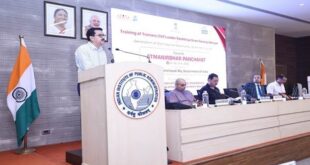- Recently, the High Court of Bombay noted that arguable issues have been raised in a Public Interest Litigation (PIL) challenging the “lifetime status of the rank of Cabinet minister” according to Pratap Singh Rane, a six-time Chief Minister of Goa and a legislator for a full 50 years.
- The PIL has contended that Goa has a 12-member Cabinet, and the conferment of Cabinet status on Rane results in the number of Cabinet ranks rising to 13, which exceeds the ceiling mandated by the Constitution.
- This limit was set by 91st Amendment) Act, 2003 to the Indian Constitution.
91st Amendment Act
- The Constitution (91st Amendment) Act, 2003 inserted clause 1A in Article 164, which says “the total number of Ministers, including the Chief Minister, in the Council of Ministers in a State shall not exceed 15% of the total number of members of the Legislative Assembly of that State.
- It also provided that the number of Ministers, including the Chief Minister in a State shall not be less than twelve”.
- Similar amendments were also made under Article 75
- According to it, the PM shall be appointed by the President and the other Ministers shall be appointed by the President on the advice of the PM.
- The total number of ministers, including the Prime Minister, in the COM shall not exceed 15% of the total strength of the Lok Sabha.
- The purpose of the 91st Amendment was to prevent jumbo Cabinets and the resultant drain on the public exchequer.
Council of Ministers
- Article 74 of the Constitution deals with the status of the council of ministers while Article 75 deals with the appointment, tenure, responsibility, qualification, oath and salaries and allowances of the ministers.
- The COM consists of three categories of ministers, namely, cabinet ministers, ministers of state, and deputy ministers. At the top of all these ministers stands the Prime Minister.
- These head the important ministries of the Central government like home, defense, finance, external affairs and so forth.
- The Cabinet is the chief policy formulating body of the Central government.
- These can either be given independent charge of ministries/ departments or can be attached to cabinet ministers.
Public Interest Litigation
- Public interest Litigation (PIL) means litigation filed in a court of law, for the protection of “Public Interest”, such as Pollution, Terrorism, Road safety, Constructional hazards etc.
- Any matter where the interest of the public at large is affected can be redressed by filing a Public Interest Litigation in a court of law.
- Public interest litigation is not defined in any statute or in any act. It has been interpreted by judges to consider the intent of the public at large.
- Public interest litigation is the power given to the public by courts through judicial activism.
- However, the person filing the petition must prove to the satisfaction of the court that the petition is being filed for a public interest and not just as frivolous litigation by a busy body.
- The court can itself take cognizance of the matter and proceed suo motu or cases can commence on the petition of any public spirited individual.
Some of the matters which are entertained under PIL are:
- Bonded Labour matters
- Neglected Children
- Non-payment of minimum wages to workers and exploitation of casual workers
- Atrocities on women
- Environmental pollution and disturbance of ecological balance
- Food adulteration
- Maintenance of heritage and culture
SOURCE: THE HINDU,THE ECONOMIC TIMES,MINT
 Chinmaya IAS Academy – Current Affairs Chinmaya IAS Academy – Current Affairs
Chinmaya IAS Academy – Current Affairs Chinmaya IAS Academy – Current Affairs



